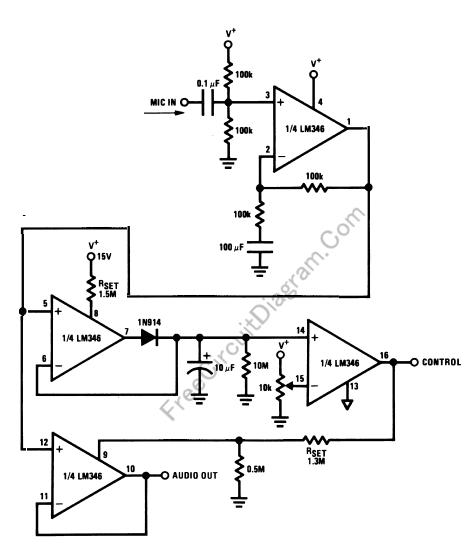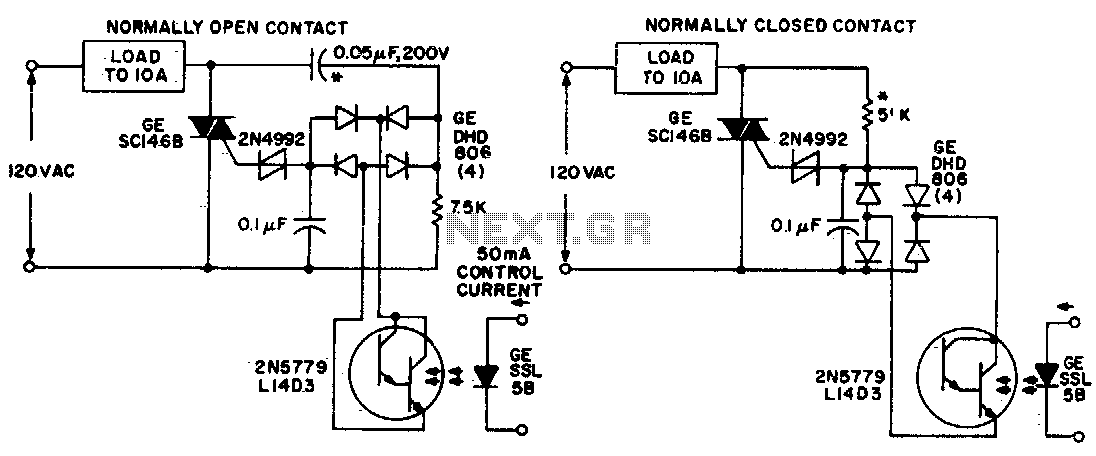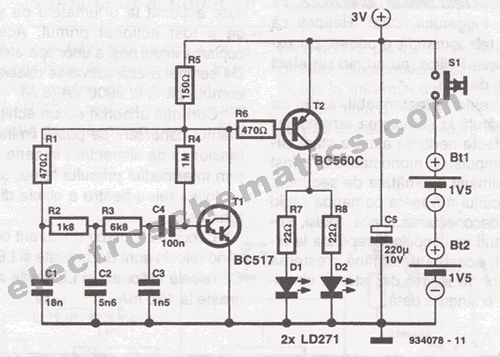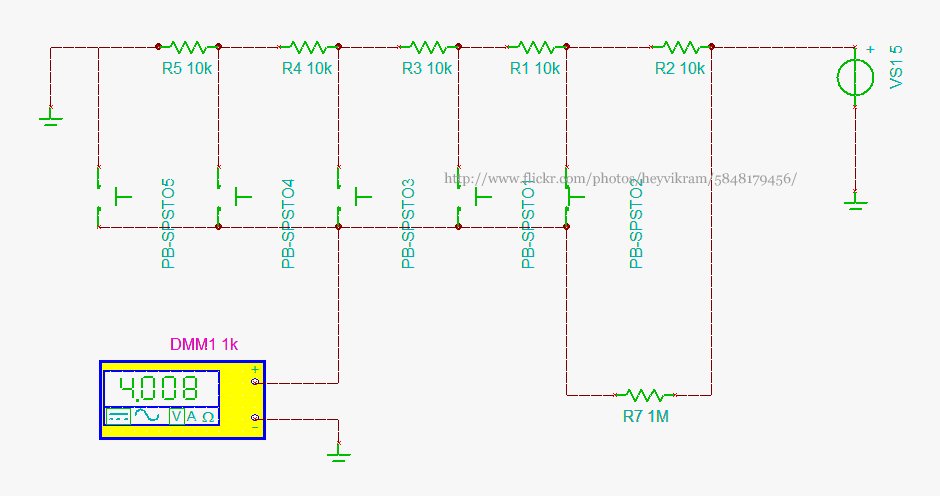
Voice Operated Switch (VOX) Circuit Using LM346 For Public Address Amplifier System

Feedback in a public address amplifier should be avoided. The ideal solution is to adjust the positions of the microphone and speaker; however, this is not always feasible in many situations. A frequency shifter that alters the output frequency to 10 Hz lower than the input frequency can address the issue, but it is often too costly for low-budget applications. A more economical solution is the voice-operated switch (VOX), which can be implemented using the LM346 programmable operational amplifier. According to its datasheet, pulling the SET pin(s) to V- causes the op-amp(s) to shut down, transitioning its output to a high-impedance state. This characteristic allows the LM346 to function as a low-speed analog switch for VOX applications. The schematic diagram of the VOX circuit is as follows: the first op-amp acts as a buffer for the microphone with a gain of 2. The second op-amp and the 1N914 diode are configured as a peak follower, which quickly follows the signal peak but slowly falls due to the charge on the 10 µF capacitor being unable to be discharged by the op-amp output (blocked by the diode) and instead discharging through a 10 MΩ resistor. This slow discharge ensures that the voice signal is not muted during brief silences between words and sentences. The third op-amp is set up as a comparator, with an adjustable reference via a 10 kΩ potentiometer. This potentiometer must be adjusted to establish the appropriate sound level that activates the VOX circuit. The final op-amp is responsible for voice muting, occurring when the control voltage output drops to zero due to insufficient sound level detected by the microphone. The microphone should be connected to the MIC IN, and the AUDIO OUT should be connected to the microphone input of the amplifier. The CONTROL output of this VOX circuit can be used to operate other devices, such as relays or lamps.
The VOX circuit utilizes the LM346 for its flexible configuration and low-cost implementation, making it suitable for public address systems where feedback is a concern. The design effectively manages audio input, ensuring that the voice signal is amplified without interference or unwanted noise. The first op-amp serves as a buffer, providing a stable gain of 2, which enhances the microphone's output signal while maintaining the integrity of the audio.
The peak follower configuration, comprising the second op-amp and diode, is crucial for capturing the transient peaks of the audio signal. The 10 µF capacitor allows for a gradual discharge through the 10 MΩ resistor, which is essential for preserving the continuity of the audio output during brief pauses in speech. This design choice prevents abrupt silencing, contributing to a more natural listening experience.
The comparator stage, with its adjustable reference level, provides flexibility in tuning the system to respond to varying sound levels. This adjustability is particularly important in environments with fluctuating background noise, allowing the VOX circuit to remain responsive to the desired audio input while ignoring irrelevant sounds.
Finally, the voice muting stage ensures that the system only activates when the microphone detects sufficient audio input, preventing false triggering and unnecessary operation of connected devices. The CONTROL output can be integrated into a broader system, enabling automation of various functions based on the presence of sound, thereby enhancing the overall functionality of the public address system. The implementation of this VOX circuit demonstrates an effective approach to managing audio feedback while maintaining cost-effectiveness in design.Feedback in public address amplifier is something that should be avoided. The ideal solution is by adjusting the microphone and the speaker position, but it`s not always possible in many situation. Using frequency shifter to change the output frequency 10Hz lower than the input frequency can solve the problem, but it`s too expensive for a low cost
public address system. Voice operated switch is one cheap working solution (see the circuit`s schematic diagram). LM346 is programmable operational-amplifier. According to its data sheet, by pulling the SET pin(s) to V- the op amp(s) shuts down and its output goes to a high impedance state. Using this property, the LM346 can be used as a low speed analog switch for VOX (Voice operated switch) application.
The figure below shows the schematic diagram of the VOX circuit. The first op-amp is the buffer for the microphone with gain=2. The second op-amp and the diode 1N914 is configured as peak follower, follow immediately the signal peak but falls down slowly because the charge of the 10uF capacitor can`t be sinked by op-amp output (blocked by the diode) and must be discharged slowly through 10M resistor. This slow discharging ensure the voice signal is not muted at short silence between words and sentences.
The third op-amp is configured as a comparator, which its reference is adjustable via 10k Pot. This potentiometer should be adjusted to set the proper level where the sound activate this VOX circuit. The last op-amp doing the voice muting, when the control voltage output drop to zero because no sufficient sound level detected on the microphone.
Connect your microphone to MIC IN, and connect the AUDIO OUT to your microphone input of your amplifier. The CONTROL output of this VOX circuit is provided to control other equipment such as relay or lamps.
[circuit schematic diagram source: National Semiconductor`s LM146/LM346 Programmable Quad Operational Amplifiers Application Notes] 🔗 External reference
The VOX circuit utilizes the LM346 for its flexible configuration and low-cost implementation, making it suitable for public address systems where feedback is a concern. The design effectively manages audio input, ensuring that the voice signal is amplified without interference or unwanted noise. The first op-amp serves as a buffer, providing a stable gain of 2, which enhances the microphone's output signal while maintaining the integrity of the audio.
The peak follower configuration, comprising the second op-amp and diode, is crucial for capturing the transient peaks of the audio signal. The 10 µF capacitor allows for a gradual discharge through the 10 MΩ resistor, which is essential for preserving the continuity of the audio output during brief pauses in speech. This design choice prevents abrupt silencing, contributing to a more natural listening experience.
The comparator stage, with its adjustable reference level, provides flexibility in tuning the system to respond to varying sound levels. This adjustability is particularly important in environments with fluctuating background noise, allowing the VOX circuit to remain responsive to the desired audio input while ignoring irrelevant sounds.
Finally, the voice muting stage ensures that the system only activates when the microphone detects sufficient audio input, preventing false triggering and unnecessary operation of connected devices. The CONTROL output can be integrated into a broader system, enabling automation of various functions based on the presence of sound, thereby enhancing the overall functionality of the public address system. The implementation of this VOX circuit demonstrates an effective approach to managing audio feedback while maintaining cost-effectiveness in design.Feedback in public address amplifier is something that should be avoided. The ideal solution is by adjusting the microphone and the speaker position, but it`s not always possible in many situation. Using frequency shifter to change the output frequency 10Hz lower than the input frequency can solve the problem, but it`s too expensive for a low cost
public address system. Voice operated switch is one cheap working solution (see the circuit`s schematic diagram). LM346 is programmable operational-amplifier. According to its data sheet, by pulling the SET pin(s) to V- the op amp(s) shuts down and its output goes to a high impedance state. Using this property, the LM346 can be used as a low speed analog switch for VOX (Voice operated switch) application.
The figure below shows the schematic diagram of the VOX circuit. The first op-amp is the buffer for the microphone with gain=2. The second op-amp and the diode 1N914 is configured as peak follower, follow immediately the signal peak but falls down slowly because the charge of the 10uF capacitor can`t be sinked by op-amp output (blocked by the diode) and must be discharged slowly through 10M resistor. This slow discharging ensure the voice signal is not muted at short silence between words and sentences.
The third op-amp is configured as a comparator, which its reference is adjustable via 10k Pot. This potentiometer should be adjusted to set the proper level where the sound activate this VOX circuit. The last op-amp doing the voice muting, when the control voltage output drop to zero because no sufficient sound level detected on the microphone.
Connect your microphone to MIC IN, and connect the AUDIO OUT to your microphone input of your amplifier. The CONTROL output of this VOX circuit is provided to control other equipment such as relay or lamps.
[circuit schematic diagram source: National Semiconductor`s LM146/LM346 Programmable Quad Operational Amplifiers Application Notes] 🔗 External reference
Warning: include(partials/cookie-banner.php): Failed to open stream: Permission denied in /var/www/html/nextgr/view-circuit.php on line 713
Warning: include(): Failed opening 'partials/cookie-banner.php' for inclusion (include_path='.:/usr/share/php') in /var/www/html/nextgr/view-circuit.php on line 713





